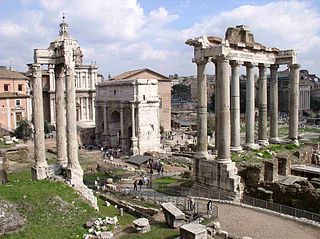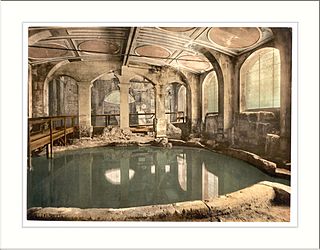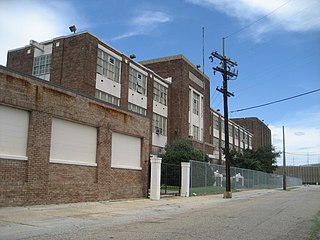
New Orleans is a consolidated city-parish located along the Mississippi River in the southeastern region of the U.S. state of Louisiana. With an estimated population of 391,006 in 2018, it is the most populous city in Louisiana. A major port, New Orleans is considered an economic and commercial hub for the broader Gulf Coast region of the United States.

The French Quarter, also known as the Vieux Carré, is the oldest neighborhood in the city of New Orleans. After New Orleans was founded in 1718 by Jean-Baptiste Le Moyne de Bienville, the city developed around the Vieux Carré, a central square. The district is more commonly called the French Quarter today, or simply "The Quarter," related to changes in the city with American immigration after the Louisiana Purchase. Most of the extant historic buildings were constructed either in the late 18th century, during the city's period of Spanish rule, or were built during the first half of the 19th century, after U.S. annexation and statehood.

"Arrested decay" is a term coined by the State of California, United States to explain how it would preserve its Bodie State Historic Park. A more common application of this concept is the preservation of war ruins as memorials.

Ruins are the remains of human-made architecture: structures that were once intact have fallen, as time went by, into a state of partial or total disrepair, due to lack of maintenance or deliberate acts of destruction. Natural disaster, war and population decline are the most common root causes, with many structures becoming progressively derelict over time due to long-term weathering and scavenging.

As with other cities in Ireland, Limerick has a history of great architecture. A 1574 document prepared for the Spanish ambassador attests to its wealth and fine architecture:

Ury House is a large ruined mansion in Aberdeenshire, Scotland, built in the Elizabethan style in 1885 by Sir Alexander Baird, 1st Baronet. It is situated on the north-east coast about 1 mile (1.6 km) north of Stonehaven in the former county of Kincardineshire.

"The Ruin" is an elegy in Old English, written by an unknown author probably in the 8th or 9th century, and published in the 10th century in the Exeter Book, a large collection of poems and riddles. The poem evokes the former glory of a ruined Roman city by juxtaposing the grand, lively past state with the decaying present.

Historic districts in the United States are designated historic districts recognizing a group of buildings, properties, or sites by one of several entities on different levels as historically or architecturally significant. Buildings, structures, objects and sites within a historic district are normally divided into two categories, contributing and non-contributing. Districts greatly vary in size: some have hundreds of structures, while others have just a few.

In the law regulating historic districts in the United States, a contributing property or contributing resource is any building, object, or structure which adds to the historical integrity or architectural qualities that make the historic district, listed locally or federally, significant. Government agencies, at the state, national, and local level in the United States, have differing definitions of what constitutes a contributing property but there are common characteristics. Local laws often regulate the changes that can be made to contributing structures within designated historic districts. The first local ordinances dealing with the alteration of buildings within historic districts was in Charleston, South Carolina in 1931.
The World Trade Center of New Orleans is the founding member of the World Trade Centers Association, a worldwide association of over 300 World Trade Centers in nearly 100 countries. The mission of the World Trade Center of New Orleans is to create jobs and wealth in Louisiana through international trade.

The buildings and architecture of New Orleans are reflective of its history and multicultural heritage, from Creole cottages to historic mansions on St. Charles Avenue, from the balconies of the French Quarter to an Egyptian Revival U.S. Customs building and a rare example of a Moorish revival church.

The Octagon, built in 1834, is a historic octagonal building and attached apartment block complex located at 888 Main Street on Roosevelt Island in New York City. It originally served as the main entrance to the New York City Mental Health Hospital, which opened in 1841. Designed by Alexander Jackson Davis, the five-story rotunda was made of blue-gray stone that was quarried on the island. The Octagon is the last remnant of the hospital, and after many years of decay and two fires, was close to ruin. After restoration, it has now been incorporated into the adjacent buildings to create a large apartment complex.

Reconstruction is a term in architectural conservation whose precise meaning varies, depending on the context in which they are used.

The Venice Canal Historic District is a district in the Venice section of Los Angeles, California. The district is noteworthy for its man-made canals built in 1905 by developer Abbot Kinney as part of his Venice of America plan. Kinney sought to recreate the appearance and feel of Venice, Italy, in Southern California.

Mega Zeph is a roller coaster found at Six Flags New Orleans, in the Eastern New Orleans area of New Orleans, Louisiana, United States. Originally opening on May 20, 2000, as Jazzland's signature ride, the coaster has been abandoned and left in a state of decay as a result of the park's closure following 2005's Hurricane Katrina.

The Smallpox Hospital, sometimes referred to as the Renwick Smallpox Hospital and later the Maternity and Charity Hospital Training School, was a hospital located on Roosevelt Island in Manhattan, New York City. Originally designed by architect James Renwick Jr., the 100-bed hospital opened in 1856, when the area was known as Blackwell's Island.

The Warrior Hotel is a historic structure located in downtown Sioux City, Iowa, United States.

Booker T. Washington High School was a high school in New Orleans, in the U.S. state of Louisiana. The school closed as a result of destruction and student displacement caused by Hurricane Katrina.

Le Grand Canal is an oil on canvas painting by French Impressionist painter Claude Monet (1840–1926). It is one of six paintings looking down the Grand Canal towards the Salute church. This Grand Canal series is in turn part of a larger series of paintings of Venice which Monet undertook during 1908 on his only visit to the city. The artist is generally regarded by art historians as being at the peak of his powers at this period. The paintings were begun en plein air and completed in France.

The St. Louis Hotel was built in 1838 at the corner of St. Louis and Chartres Street in New Orleans, Louisiana, United States. Originally it was referred to as the City Exchange Hotel.
























